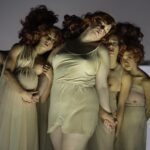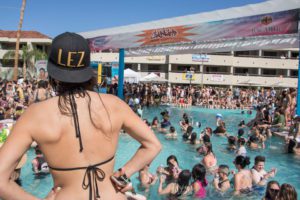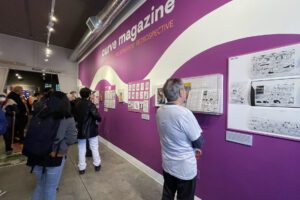
by
The San Francisco Dyke March celebrates its 20th anniversary this weekend with a new generation of leadership remembering the rally’s roots born of a call for dyke rights and visibility.
Marking the anniversary, the 10 all-volunteer committee members have scaled back the event to remind people about its political beginnings, said organizers.
This year’s theme is “Dyke Space Continuum,” to express the past and ongoing efforts for queer women’s rights.
“It’s really political for me still,” says Clair Henry, a 27-year-old lesbian who is a second-year committee member.
Clair is well aware that the Dyke March’s image is misconstrued as another Pride Parade.
“That’s not why it started … and that’s not what it is. I still think that we need to draw so much attention to the issues that women and lesbians face every day. There is a perception that women have equal rights and that gay people have mostly equal rights except for marriage … that is so patently false.”
Lila Thirkield, a core Dyke March committee member and owner of the Lexington Club, agrees.
“We live in a world where women are not treated the same way as men and that exists in the gay arena too,” says Lila, pointing out that women continue to earn less than men and there usually tends to be a ratio of one lesbian bar to 30 gay men’s bars in a city. “That visibility is why [the Dyke March] started out in the first place. [The original organizers] wanted people to see that we are a part of the community.”
The event begins in Dolores Park at noon Saturday, June 23 and will highlight lesbian DJs throughout the park, rather than the traditional performers and speakers that have brought out waves of celebrants to hang out and picnic in the park throughout the day.
The celebration will wrap up at 5 p.m. for marchers to gather around 18th and Dolores streets where Latina lesbian performance artist and scholar Cherrie Moraga and Krys Freeman, founder of masculine-of-center social network theDefinition and Butch Voices co-chair, will inspire the crowd.
The march will kick off at 6, an hour earlier than usual, with the dyke motor contingent and the disabled and senior trolley winding its way through the Mission, ending at the Pink Saturday celebration in the Castro.
This year’s event will also be greener. Attendees will notice bins for compost, recycling, and trash, which for organizers is “taking care of the imprint” in the park and “paramount in what we are doing” taking care of basics, says Lila.


Dyke revolution
The Dyke March started 20 years ago at the height of the AIDS epidemic. The crisis perpetuated lesbians being in the shadows of the Gay Liberation Movement, rendering them invisible rather than a significant part of the movement, especially during the early years of AIDS when lesbians were the caretakers of their gay male friends, said march founders.
Tired of being invisible, leaders of three West Coast lesbian and feminist organizations came together with New York City’s fire-eating Lesbian Avengers to plan a “spontaneous” march on Washington the night before the official March on Washington April 25, 1993, recall founding members Leslie Mullin, 67, and Lisa Roth, 62.
The organizers named their political action the “Dyke March.” It was in the spirit of the time when people were taking back traditionally derogatory words, such as “dyke,” which historically was a slur used against lesbians.
“There are a lot of women-loving-women who don’t like the term dyke. I love it. Dyke is a very strong word,” said L.A./Happy Hyder, 65, who has served on the committee for the past five years and has participated in the Dyke March since its beginning.
Networking and spreading the news through women’s bookstores and organizations the event planners were shocked and surprised to see an estimated 20,000 women gathered at Dupont Circle on April 24, 1993. They took to the capital’s streets and projected a lesbian art show onto the Washington Monument, making front-page news in the Washington Post.
“You don’t think that you are making history. You think you are doing what you are doing,” says Lisa, who served on the committee for more than a decade.
“There was something about this idea that really appealed to women,” adds Leslie, who served on the committee for nearly 15 years. “It speaks to a very fundamental desire to have a voice and to be recognized and to be visible. It’s a way of showing power. It’s a form of power to assemble that way and march through the streets. Women like to feel powerful and we don’t get to feel that powerful that much.”
High off of the energy and success of the march in Washington, organizers returned home and called all dykes to take to the streets of the “gay mecca” on June 26, 1993, the eve of the San Francisco Pride Parade, what is now known as Pink Saturday.
The beginnings were humble and political.
“The Dyke March … is a dyke march in part because dykes have been so invisible. To establish that visibility, just us in those numbers, we comprise a diverse community – a huge diverse community,” says Mo Kalman, pointing out the march symbolizes for many queer women that “I’m not alone.”
“If nothing else the sheer numbers and the presence of the Dyke March is a beacon that says, ‘Hey, we are here. You are cool. Be who you are and it’s okay,'” says Mo.


Dyke rights, human rights
“One thing that is kind of very significant about the Dyke March is that it’s not just about dyke rights,” says Mo, pointing out that historically the march has also addressed through its themes anti-apartheid, peace, uprooted racism, universal health care, and more.
“Every year there is a different theme. The politics, the cultural, and the socioeconomic issues and what is going on internationally are all things that we think about in terms of sending a message out to our communities and the world,” says Mo. “It helps dykes see that no one is going to be liberated until everybody is.”
At the same time, the Dyke March is a celebration, in spite of the criticism over the years that it has lost focus and has become more of a Pride event than a political one.
“It’s a party. I don’t see it as a political event anymore. I think that it’s a great day for people to come out and be seen,” says Fresh White, a 49-year-old transgender dyke butch, who served on the committee for two years before joining the Trans March committee, where he now serves as an adviser.
Dyke March founders and current committee members don’t see any conflict between the cultural and political aspects of the event.
“The celebration and the politics were never in conflict because it was always a celebration of lesbians,” says Lisa. “It was also a platform to articulate the visions,” of the lesbian community.
“Culture is political and they are not mutually exclusive,” agrees Mo.
For years, the Dyke March has supported queer women performers on its stage in the park, even providing stipends at times, say Happy and Mo.
Celebration of community
One of the Dyke March’s biggest successes is that it is the most accessible large event for people with disabilities and seniors, say community members and march organizers.
Every year the march has a donated trolley car that allows disabled and senior dykes to participate in the parade and special seating at the celebration and along the parade route at 16th and Dolores streets.
Empowerment also meant keeping the power. While the Dyke March is political it has kept out politicians and remained grassroots, running on donations and resisting the temptation to allow corporate sponsors to assist with event production costs that are now up to $35,000, says Happy.
As the event grew, Dyke March committee members also maintained control while working hand-in-hand with city officials and police to keep the event accessible and safe.
The decision to remain independent along with staying an all-volunteer operation as a fiscally sponsored organization of Community Initiatives, rather than become more formally organized with a board and executive director nearly caused the San Francisco Dyke March not to happen last year.
The community became alarmed and pulled together when the core committee members announced the pending shut down of the march. The Dyke March went on as scheduled.
“Simply continuing for 20 years and much of that on a shoestring, I think that in itself shows the determination,” says Happy.
The 20-year tradition of dykes taking to the queer streets of San Francisco attracts an estimated 50,000 participants and supporters every year on Pink Saturday during Pride weekend, according to march organizers.
It has grown into the largest Dyke March in the country since it began in 1993, organizers say.
“It’s really significant that we still want to march in the streets,” says Happy. “We still want to do this. We still want to come out and show who we are. I think that’s really fabulous, because we understand that we still haven’t gotten everything we need, which is equal rights as women, as being out lesbians or out dykes.”
“I’m glad that we still want to make that statement,” Happy continues.


Women waves
“It was a very exhilarating experience to be walking down the street with her, holding hands amongst this sea of dykes with people hanging out of their windows cheering us on,” says Mo, 59, about marching with her girlfriend of more than 20 years, Susan Goldberg. “Just felt a lot of love basically … not the least bit threatened by anything and a sense of freedom that I don’t think that I quite experienced before.”
Mo, a tenants’ rights attorney, started out volunteering on various aspects of the march before taking over stage managing and production duties. When the founders expressed their desire to retire in the early 2000s, she couldn’t allow the Dyke March to die, she tells Girls That Roam.
She rallied her friends and wound up serving as a committee member for the past decade, she says while searching through her computer for historic photos at her Bernal Heights home office.
“It’s a pretty awe inspiring event just walking up to the park with all of those women there,” says Lila, 40.
Rosa Hernandez, also known as DJ Rumorosa, keeps the music pumping on the back of a truck as women follow her beat through the streets. The march means a little bit more to her as a queer Latina. For years she’s always been “amazed, moved, and inspired,” not only by the sea of women, but also as a Latina marching through the Mission District, she says.
One of the many successes of the San Francisco Dyke March is the organizers’ purposeful actions to diversify the event internally – by recruiting committee members from ethnic and gender variant communities and various sexual identities – and externally welcoming all women – queer and straight – to march, say organizers.
It wasn’t an easy discussion as gender and sexual fluidity emerged in the early 2000s confronting the Dyke March. Ultimately, the decision was made to take away the “women-only” requirement and embrace the ever-expanding definition of “dyke,” says Mo.
“The definition of dyke has shifted over the years. We have a very gender fluid dyke community. That’s a lovely thing. We have learned how to celebrate each other in who we are and how we present to the world,” says Happy.
The line remains drawn with men, however, who are still asked to support the Dyke March from the sidelines, says Mo.
New generation
This year a new wave of leaders are being trained by the second generation of leaders, who took over from the founders as they prepare to hand down the organization, says Mo.
“Every woman who is involved is so passionate and invested in it and wants to give back to the community,” says Clair. “It means a lot to me and I think it means a lot to a lot of other women. It feels pretty awesome to be a part of that.”
The founders can still be found in the crowds collecting money to support the cause they started, says Lisa.
“I hope it continues to grow and continues to celebrate the aspects of lesbian rights, dignity, and equality as it should do until we have all of the things that we need,” says Lisa.
Mo is confident that the Dyke March’s “future is bright.”
“We could be going for the next 20 to 40 years,” she says.
Interested in volunteering the day of the Dyke March? Contact
Originally published by the Bay Area Reporter.
To contract an original article, purchase reprints or become a media partner, contact







